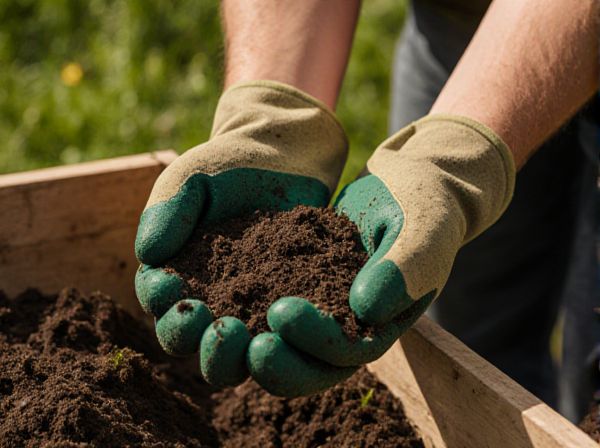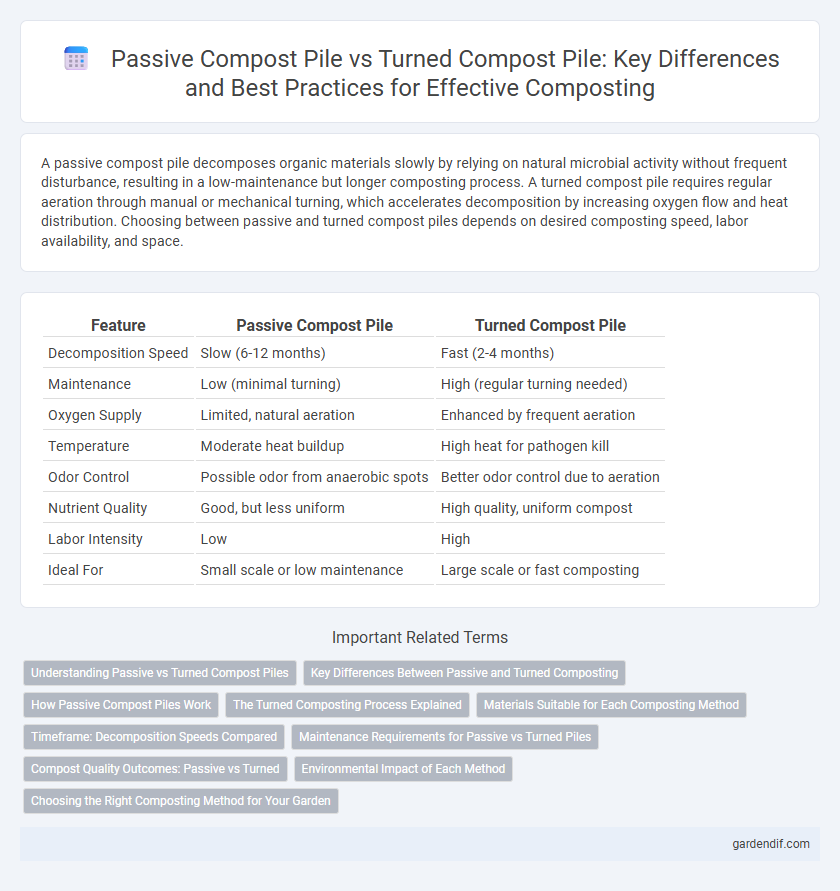
Passive compost pile vs Turned compost pile Illustration
A passive compost pile decomposes organic materials slowly by relying on natural microbial activity without frequent disturbance, resulting in a low-maintenance but longer composting process. A turned compost pile requires regular aeration through manual or mechanical turning, which accelerates decomposition by increasing oxygen flow and heat distribution. Choosing between passive and turned compost piles depends on desired composting speed, labor availability, and space.
Table of Comparison
| Feature | Passive Compost Pile | Turned Compost Pile |
|---|---|---|
| Decomposition Speed | Slow (6-12 months) | Fast (2-4 months) |
| Maintenance | Low (minimal turning) | High (regular turning needed) |
| Oxygen Supply | Limited, natural aeration | Enhanced by frequent aeration |
| Temperature | Moderate heat buildup | High heat for pathogen kill |
| Odor Control | Possible odor from anaerobic spots | Better odor control due to aeration |
| Nutrient Quality | Good, but less uniform | High quality, uniform compost |
| Labor Intensity | Low | High |
| Ideal For | Small scale or low maintenance | Large scale or fast composting |
Understanding Passive vs Turned Compost Piles
Passive compost piles rely on natural microbial activity without human intervention, resulting in slower decomposition and lower temperature levels. Turned compost piles require regular aeration through manual or mechanical turning, which accelerates breakdown and maintains higher temperatures, promoting faster composting. Understanding the differences helps optimize composting efficiency based on time availability and desired nutrient output.
Key Differences Between Passive and Turned Composting
Passive compost piles decompose organic waste slowly through natural microbial activity with minimal disturbance, requiring less labor but producing compost over a longer period. Turned compost piles involve regular aeration by mixing or turning, which accelerates decomposition by increasing oxygen flow and generating higher temperatures for faster pathogen breakdown. Key differences include decomposition speed, oxygen availability, temperature control, and maintenance effort, with turned piles offering quicker, more uniform compost compared to the slower, low-maintenance passive method.
How Passive Compost Piles Work
Passive compost piles work by relying on natural decomposition processes without regular turning, allowing organic materials to break down slowly through microbial activity and natural aeration. These piles maintain moisture and temperature by layering and compacting materials strategically, which supports gradual nutrient cycling while minimizing labor. The slower breakdown in passive composting conserves energy but requires more time to achieve fully decomposed, nutrient-rich compost compared to turned compost piles.
The Turned Composting Process Explained
The turned composting process involves regularly aerating the organic materials by manually or mechanically mixing the pile to accelerate decomposition and maintain optimal oxygen levels. This method promotes faster breakdown of carbon-rich and nitrogen-rich materials, reducing composting time from several months to weeks. Turned compost piles typically achieve higher temperatures, improving pathogen destruction and resulting in nutrient-rich, well-balanced compost ideal for gardening and agriculture.
Materials Suitable for Each Composting Method
Passive compost piles are best suited for materials that break down slowly, such as woody branches, leaves, and other high-carbon materials, allowing natural decomposition over time. Turned compost piles benefit from a balanced mix of greens like kitchen scraps and fresh grass clippings with browns such as straw and shredded paper, enabling faster aerobic breakdown through regular aeration. Understanding the carbon-to-nitrogen ratio and moisture content of these materials optimizes decomposition efficiency in both composting methods.
Timeframe: Decomposition Speeds Compared
Passive compost piles decompose organic materials at a slower pace, often taking 6 to 12 months to fully break down due to limited oxygen circulation. Turned compost piles speed up decomposition by promoting aeration and microbial activity, typically completing in 2 to 4 months. Efficient turning every few weeks optimizes temperature and moisture, significantly accelerating the breakdown of organic waste.
Maintenance Requirements for Passive vs Turned Piles
Passive compost piles require minimal maintenance, allowing organic materials to decompose slowly over time with little intervention. Turned compost piles demand regular aeration through manual or mechanical turning to enhance oxygen flow and accelerate decomposition. Frequent turning also helps to control moisture levels and temperature, reducing the risk of odor and promoting faster nutrient-rich compost production.
Compost Quality Outcomes: Passive vs Turned
Passive compost piles decompose more slowly, resulting in less aeration and potentially uneven nutrient distribution, which can cause lower overall compost quality and longer maturation times. Turned compost piles benefit from regular aeration and moisture control, promoting faster microbial activity and more consistent breakdown of organic materials, leading to higher-quality, nutrient-rich compost. Consistent turning also helps reduce odor and pathogen presence, enhancing the safety and usability of the final product.
Environmental Impact of Each Method
Passive compost piles generate fewer greenhouse gas emissions due to limited aeration, reducing carbon footprint but potentially causing slower organic matter breakdown and methane production. Turned compost piles enhance oxygen flow, accelerating decomposition and minimizing methane release, which contributes to a lower overall environmental impact despite increased labor and energy input. Evaluating these methods requires balancing emission levels, processing time, and resource consumption to achieve sustainable waste management.
Choosing the Right Composting Method for Your Garden
A passive compost pile requires minimal maintenance, relying on natural decomposition processes, making it ideal for gardeners with limited time. In contrast, a turned compost pile accelerates decomposition through regular aeration, producing nutrient-rich compost faster and promoting a healthier garden soil ecosystem. Selecting the appropriate method depends on your gardening goals, available time, and desired compost quality.
Passive compost pile vs Turned compost pile Infographic

 gardendif.com
gardendif.com